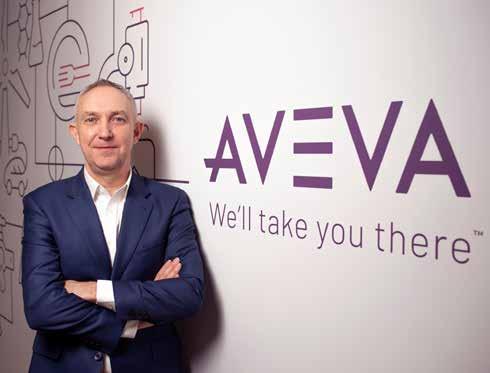
4 minute read
OUR BRAVE NEW NORMAL
OUR BRAVE NEW NORMAL CRAIG HAYMAN, CEO OF AVEVA, ON HOW AI AND CLOUD WILL DRIVE SUCCESS IN THE POST-COVID19 WORLD
In the past two months, we have found ourselves in a brave new world of remote working, digitalled interactions, and increased uncertainty. At AVEVA, it’s our mission to help teams seize the opportunities this environment brings, striving to protect lives and livelihoods for the companies and communities we serve.
Advertisement
As a company specialising in digital transformation, we have pivoted to digital-first working practices for our own team and to support our customers.
But success in a post-COVID-19 world will be about more than connecting your workforce and shifting to IIOTenabled operating models. It will be about thinking differently, both in terms of scale and how we approach business challenges. And here, there are two transformative opportunities which we believe will shape a sustainable future for the industries we serve, and the world around us. These are: cloud and artificial intelligence, known as AI.
How do cloud and AI change the game?
Let’s start with AI. It’s been around for more than 30 years, and it’s becoming broader and more sophisticated. This is important, because it enables companies to accelerate how they work. With unified smart analytics that span complete data stacks, teams can leverage mathematical thought processes across all their activities. This gives individuals scale and capacity that they would not otherwise have – knowledge, data-led intelligence, the ability to spot opportunities. It enables people to make better decisions – and to use smart systems to recommend courses of action – that enhance the capabilities of the human workforce.
At AVEVA, we use our broad portfolio to infuse AI across all aspects of the value chain, making it smarter. We’ve been doing this for 15 years in the maintenance and asset performance space with predictive analytics. Now using the cloud, we can integrate individual products, connecting AI modules together into a broader intelligence.
With integrated systems comes integrated analysis – this enables companies to generate more complex insights and recommendations for their human workforce, meaning teams can manage more complex processes, and execute them quicker. Cloud is the glue and AI the intelligence that underpins better decision-making.
Two examples of how this works in practice: Duke Energy & ENEL
Duke Energy uses AI on rotating and non-rotating equipment and achieved
savings of more than $5 million in a single catch – an operational failure that was avoided thanks to artificial intelligence. Now, we’re starting to see AI applied to manufacturing, where AI-infused manufacturing execution system (MES) can enable teams to identify issues not previously visible to the human eye. For example, using fault diagnostics AI can use predictive asset strategies to recommend mitigation actions to keep plants running efficiently.
ENEL is using next-gen predictive maintenance to leverage AI-driven simulation and forecasting, benefitting from a 360-degree view of risk that improves decision-making throughout its operations. Once an issue is identified with predictive maintenance, the team can ask: can we make it to the next planned outage, or do we need to schedule an emergency maintenance shutdown? When is the optimal time to perform maintenance in order to minimise adverse impacts on operations and associated costs? What is the likely impact of an outage and what prescriptive actions can we pre-emptively take to mitigate it? This is how next-gen technology is transforming energy production, driving efficiency and sustainability throughout an optimised value chain.
In the past, narrow AI was infused into various products. Today, using the cloud, we can scale AI to span a whole portfolio. This broader AI is the first step towards general artificial intelligence – the ability to make a complex decision using combinations of different types of AI, to learn something and apply it in another situation. This is a continuum, and it’s exciting to see the progress already being made. With the shift to digital business models following COVID-19, we see this trend accelerating, and we’re already working with customers across the globe to make that happen.
How does this affect the human workforce?
A decade ago, AI was a concept that was widely misunderstood and sometimes feared. I’m delighted to see how ever-wider adoption is dispelling
that fear and showing how AI will make workers better at what they do and enhance the human experience.
With an ageing workforce, senior experts are retiring and leaving us with a knowledge gap. Connected content, prescriptive actions and engineering that uses intelligent capabilities is transforming how companies plan,

whether through predictive operations, predictive MES, or smart SCADA. AI can provide the entire knowledge graph that spans engineering, operations and performance. By applying AI knowledge, companies are bridging generational knowledge, accelerating training and teaching people be more expert at what they do, enabling them to work more efficiently and more accurately. This same approach could be applied across other scenarios such as remote working, asset performance management and even value chain optimisation.
This is why McKinsey can so predict that AI will drive 2% growth in manufacturing and energy for the next ten years – around $1 Trillion every year. For our customers, we typically see ROI on AI investments in the $100s of millions, within a very short timescale. This is how AI will be crucial to supporting efficiency, sustainability and the ongoing viability of agile industries, in the post-COVID world. Through more efficient deployment of resources and better decision making, AI is already helping us realise the sustainable industries of the future. I’m invigorated by the fresh growth that AI and cloud together can drive, and how we are working with customers to harness this opportunity in our brave new future.










